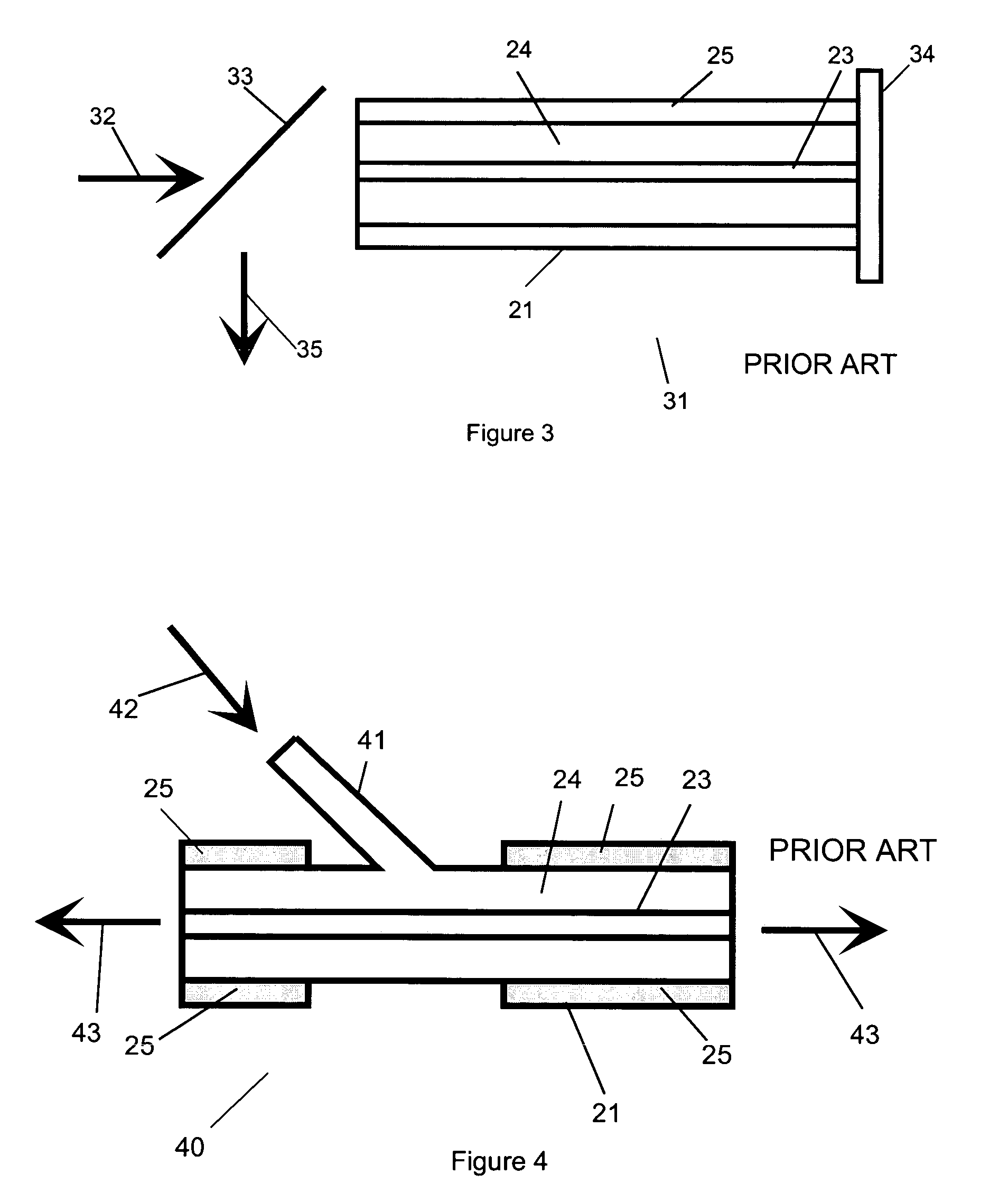Multi-fibre arrangement for high power fibre lasers and amplifiers
a multi-fibre arrangement, high-power technology, applied in the direction of fiber transmission, lasers, transmission, etc., can solve the problems of high cost, insufficient power output of amplifiers, and prone to pump source failure of conventional amplifiers, so as to improve pump absorption and thereby efficiency, the effect of small outer diameter and reducing the ratio of passive-cladding to active-core volum
- Summary
- Abstract
- Description
- Claims
- Application Information
AI Technical Summary
Benefits of technology
Problems solved by technology
Method used
Image
Examples
example i
[0192] This Example is based on the configuration depicted in FIG. 32. The amplifying optical fibre 222 has an outer diameter (OD) of 200 μm and a core diameter of 10 μm. The core is single-moded at the signal wavelength and made of Er3+ / Yb3+-activated aluminosilicate glass. The pump absorption cross section at 980 nm is 20·10−25 cm2. The Yb3+concentration is 9000 particles per million (ppm). A 10 m long fibre absorbs ˜90% of launched pump power. The pump power is provided by 4 laser diodes with rated output power of 2 W. Using the simple launching scheme shown in FIG. 32 one can launch nearly 90% of pump power into the fibre amplifier
[0193] Assuming 35% efficiency the saturated output power of the example is in the region of 2.5 W. In many applications however required output power is 1 W which can be achieved with only 2.9 to 3 W of pump power, i.e. by using only two pump diodes. Thus by down-rating all four pump diodes to 800 mW one can achieve the required level of the output p...
example ii
[0194] This Example is a mode-locked cladding pumped fibre laser with repetition rate frequency in the region of 50-200 MHz. The laser is based on the two fibre arrangement shown in FIG. 40. The amplifying optical fibre has an OD of 80 μm, core diameter of 15 μm and signal NA of 0.07. The core is single-moded at the signal wavelength and made of Yb3+-activated aluminosilicate glass. The pump absorption cross section at 980 nm is 20 X·10−25 cm2, which implies an Yb3+concentration of 1000 particles per million (ppm). A 1 m long fibre absorbs approximately 90% of launched pump power. The pump power is provided by 2 laser diodes with rated output power of 2 W.
[0195] With an appropriate mode-locking technique (either passive or active) the laser is capable of generating 1 ps pulses at repetition rate of 100 MHz and average power of 1 W and peak power in excess of 10 kW. Mirrors 401 form an optical resonator for the signal.
[0196] An advantage of using this configuration is that the sign...
example iii
[0197] This Example is a multi-fibre arrangement including two or more pump diodes pumping simultaneously several amplifying optical fibres as shown in FIGS. 33 to 36. The amplifying optical fibres have an outer diameter (OD) of 100 μm and a core diameter of 10 μm. The core is single-moded at the signal wavelength and made of Er3+ / Yb3+-activated aluminosilicate glass. The pump absorption cross section at 980 nm is 20·10−25 cm2, which implies an Yb3+concentration of 9000 particles per million (ppm). A 5 m long fibre absorbs approximately 90% of launched pump power. The pump power is provided by 4 laser diodes with rated output power of 2 W. Using the simple launching scheme shown in FIG. 6 one can launch nearly 90% of pump power into the fibre amplifier. Assuming 35% efficiency the saturated output power of the Example is in the region of 1 W from each channel. It should be understood that total amount of output power available from all channels remains approximately the same so incr...
PUM
| Property | Measurement | Unit |
|---|---|---|
| Length | aaaaa | aaaaa |
| Diameter | aaaaa | aaaaa |
| Melting point | aaaaa | aaaaa |
Abstract
Description
Claims
Application Information
 Login to View More
Login to View More - R&D
- Intellectual Property
- Life Sciences
- Materials
- Tech Scout
- Unparalleled Data Quality
- Higher Quality Content
- 60% Fewer Hallucinations
Browse by: Latest US Patents, China's latest patents, Technical Efficacy Thesaurus, Application Domain, Technology Topic, Popular Technical Reports.
© 2025 PatSnap. All rights reserved.Legal|Privacy policy|Modern Slavery Act Transparency Statement|Sitemap|About US| Contact US: help@patsnap.com



